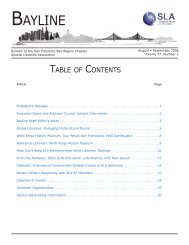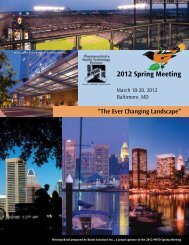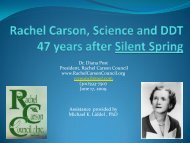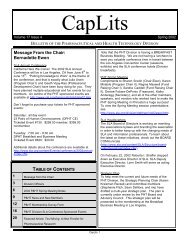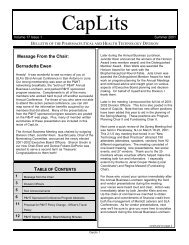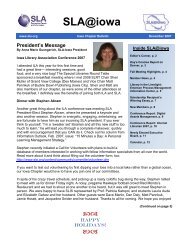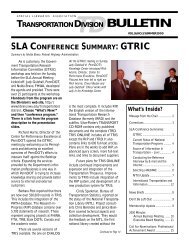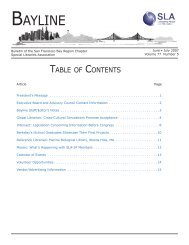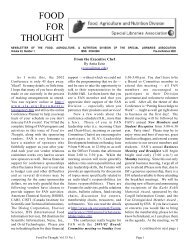Education Libraries - Special Libraries Association
Education Libraries - Special Libraries Association
Education Libraries - Special Libraries Association
Create successful ePaper yourself
Turn your PDF publications into a flip-book with our unique Google optimized e-Paper software.
What’s in a Name? K-State University at<br />
Salina<br />
To understand<br />
the importance<br />
of committing<br />
so much effort<br />
to the preservation of this collection, It’s important<br />
to be aware of the transformations the campus has<br />
seen in the last forty years. Since its inception, the<br />
institution now known as Kansas State University<br />
at Salina has been committed to advancing<br />
technological innovation within the state of<br />
Kansas. In 1965, the Kansas Legislature<br />
transformed the Schilling Air Force Base into the<br />
Schilling Institute. The change was brought about<br />
with the distinct goal of capitalizing on the<br />
technical education movement which swept the<br />
nation during the early 1960s. The Schilling<br />
Institute offered two-year degree programs in<br />
science and engineering technology. In 1969, the<br />
institution became Kansas Technical Institute as a<br />
way to further align the institution with serving<br />
this distinct student population. In an attempt to<br />
establish itself as a superior institution of higher<br />
education, the institution’s name was once again<br />
changed in April 1988 to the Kansas College of<br />
Technology. On May 2, 1991, a legislative bill<br />
merged the Kansas College of Technology with<br />
Kansas State University, creating the only remote<br />
campus for the University and establishing the<br />
ninth college in the K-State System: the College of<br />
Technology and Aviation. K-State at Salina<br />
currently offers associate and bachelor degrees in<br />
engineering technology, aviation, and business.<br />
The North Central <strong>Association</strong>, the Accreditation<br />
Board for Engineering and Technology, the<br />
Council on Aviation Accreditation, and the<br />
Federal Aviation Administration have<br />
all accredited the K-State at Salina<br />
programs.<br />
The K-State at Salina Library services<br />
a diverse population of users, including<br />
1,000 students and 200 faculty and<br />
staff members of the college itself, as<br />
well as a steady stream of institutional<br />
alumni and a variety of community<br />
patrons. Exceeding expectations from a<br />
diverse population drives the library’s<br />
mission:<br />
The mission of the K-State at Salina<br />
Library is to support the college in its<br />
mission of teaching, scholarship, and<br />
service, and to support resource sharing in<br />
the community and state. In striving to<br />
fulfill these goals, the philosophy of the<br />
library is changing. The Library is no<br />
longer a warehouse of materials; it is a<br />
facilitator of information exchange.<br />
Successful implementation of these goals is<br />
influenced by a tradition of providing print<br />
and non-print resource materials, the<br />
promise of new technologies, and welltrained<br />
library staff who facilitate<br />
information access.<br />
Development of an infrastructure to support the<br />
organization of historical documents would<br />
enhance the K-State at Salina Library’s capability<br />
to improve seamless information exchange to its<br />
neighboring population, as well as citizens of the<br />
entire state of Kansas.<br />
A Mountain of Dusty Boxes<br />
In 2007, the archives were handed down from the<br />
retiring library director to the new library director.<br />
The archives had been patiently waiting for a<br />
librarian or two brave enough to tackle the<br />
mountain of dusty boxes that seemed to multiply<br />
on their own. Various disbanded student<br />
organizations, retiring faculty, and the college’s<br />
Dean’s office had donated a great percentage of<br />
the photo materials over the years, which had<br />
piled up in a back room from a lack of other<br />
storage options. The photographers for both the<br />
Kansas College of Technology and Shilling<br />
Institute yearbooks also donated a sizeable amount<br />
of the proofs<br />
previously used in<br />
yearbook layouts,<br />
making the entire<br />
collection rather<br />
eclectic. As in other<br />
countless libraries,<br />
the staff had to get<br />
by with what little<br />
space they had and<br />
converted an old<br />
storage room into an<br />
adequate location for<br />
<strong>Education</strong> <strong>Libraries</strong>, Volume 31, No. 2, Winter 2008 33



